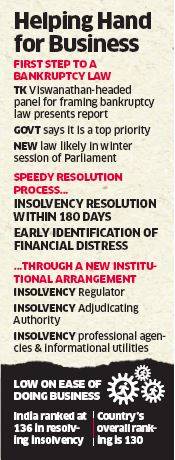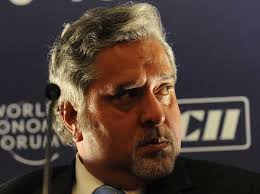
A government panel has sought the overhaul of the bankruptcy framework to allow the speedy winding up of failed businesses to protect shareholders and lenders, aiming to modernise an outdated system that drags out closure proceedings.
It has recommended new institutions and structures for a fresh regime that will encourage entrepreneurship and foster a startup culture, among the stated objectives of the Narendra Modi administration. The government has indicated it will move a Bill in the winter session of Parliament to give effect to the recommendations, addressing one of the key issues that has kept India low on the ease of doing business rankings.
The Bankruptcy Law Reform Commission headed by former law secretary TK Viswanathan has proposed insolvency resolution within 180 days and a new regulator to oversee the process. It’s also laid down a clear and speedy system for early identification of financial distress and revival of companies.
 The timelines are on par with international norms for insolvency resolution. “The endeavour would be to introduce the Bill in the next session of Parliament,” Finance Minister Arun Jaitley said at the World Economic Forum in the Capital on Wednesday. Viswanathan submitted the report to the minister later in the day. The report, along with the draft legislation, has been made public for feedback. “The Bill seeks to improve the handling of conflicts between creditors and debtors, avoid destruction of value, distinguish malfeasance vis-a-vis business failure and clearly allocate losses in macroeconomic downturns,” the report said.
The timelines are on par with international norms for insolvency resolution. “The endeavour would be to introduce the Bill in the next session of Parliament,” Finance Minister Arun Jaitley said at the World Economic Forum in the Capital on Wednesday. Viswanathan submitted the report to the minister later in the day. The report, along with the draft legislation, has been made public for feedback. “The Bill seeks to improve the handling of conflicts between creditors and debtors, avoid destruction of value, distinguish malfeasance vis-a-vis business failure and clearly allocate losses in macroeconomic downturns,” the report said.
The World Bank has ranked India at 136 out of 189 countries in ‘resolving insolvency,’ estimating that it takes 4.3 years on average in Mumbai to settle a case.
Jaitley had identified bankruptcy law reform as a key priority for improving ease of doing business in his February budget speech. He said that a comprehensive bankruptcy code, meeting global standards and providing the necessary judicial capacity, would be unveiled in the fiscal year. Under the current system, proceedings take several years, hurting investors and lenders besides costing taxpayers crores of rupees.
Banks are groaning under bad debt stemming from projects that have got stuck, drawing the Reserve Bank of India’s concern. “We need a bankruptcy code. We need equity to be seen as equity and debt to be seen as debt. Today there’s a lot of confusion… We need that confusion to be changed,” RBI Governor Raghuram Rajan has said previously.
90 Days for Key Categories. The prescribed resolution timeline of 180 days can be cut further to 90 days from the trigger date for key categories. The proposed insolvency regulator will cover professionals and agencies specialising in the field.
The proposals include information utilities that will collect, authenticate and disseminate financial information from listed companies. An Insolvency Adjudicating Authority will hear cases by or against debtors. The Debt Recovery Tribunal should be the adjudicating authority with jurisdiction over individuals and unlimited liability partnership firms, it said. The National Company Law Tribunal (NCLT) should be the adjudicating authority with jurisdiction over companies and limited liability entities, it added.
The draft bill has consolidated existing rules relating to insolvency of companies, limited liability entities, unlimited liability partnerships and individuals, all of which are currently scattered across a number of laws, into a single legislation.
According to the draft bill, during the transition phase, the Centre will exercise all regulatory powers until the agency is established. The panel’s report suggests that an insolvency resolution plan prepared by a resolution professional has to be approved by a majority of 75% of the voting share of financial creditors. As part of the insolvency resolution process, creditors and debtors will engage in negotiations to arrive at agreeable repayment plans.
The draft proposes that any proceeding pending before the Appellate Authority for Industrial and Financial Reconstruction (AAIFR) or the Board for Industrial and Financial Reconstruction (BIFR) before the new law goes into force should stand abated or stopped.
“However, a company in respect of which such proceeding stands abated may make a reference to Adjudicating Authority within 180 days from the commencement of this law,” the recommendation said, keeping in view continuity of the process. Minister of State for Finance Jayant Sinha said the required infrastructure needed to be put in place.
“We also have to ensure that necessary judicial capacity is available,” he said. “We also need to resolve many of the situations immediately because they are short of cash in most of these bankruptcy types of cases.” The minister said the government was trying to put together a comprehensive solution where “we can resolve default and bankruptcy cases as quickly and efficiently possible.”
Industry feels the new system will create a robust and globally competitive insolvency regime. This will significantly reduce the time taken for insolvency proceedings in India, which at present, on an average basis is estimated at about 4.3 years as against only 1.7 years in high-income OECD countries,” said Chandrajit Banerjee, director general of the Confederation of Indian Industry.
“The architecture proposed by the Viswanathan committee of establishing an insolvency regulator to have oversight of the new class of insolvency professionals, agencies and information utilities will enhance the systemic efficiency of dealing with insolvency cases in a timebound manner,” he said.





